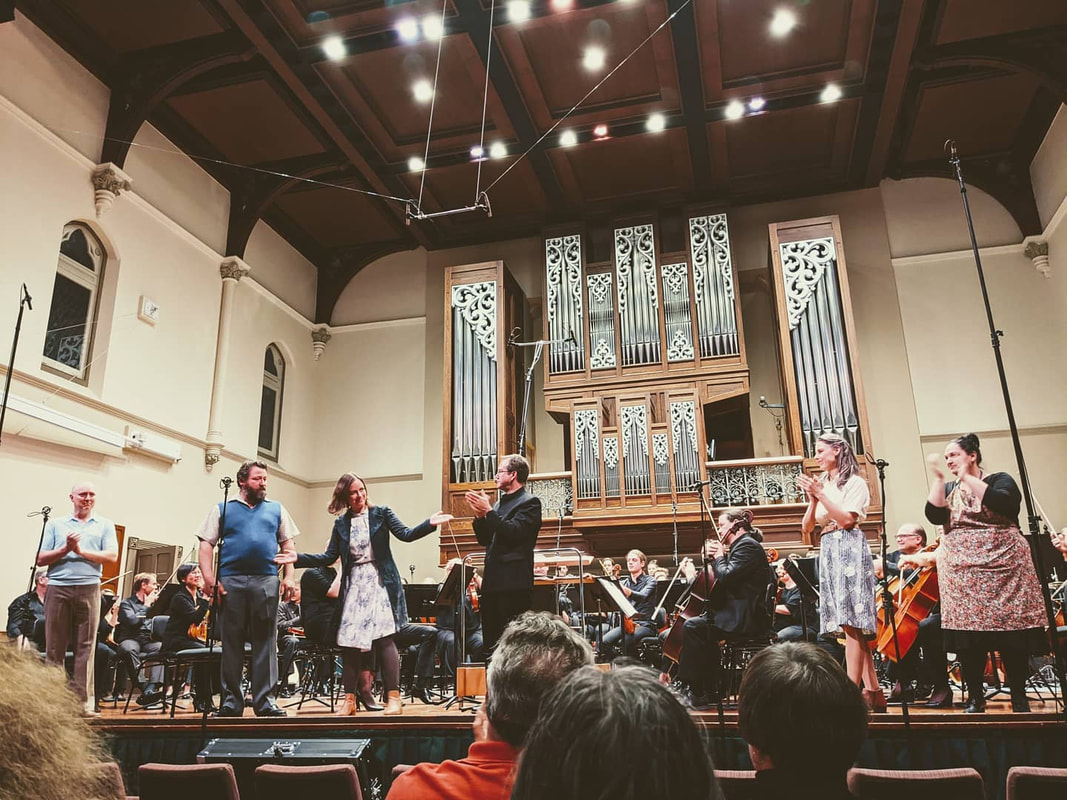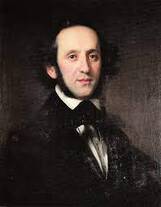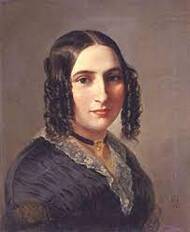|
This article was written for the Music Trust 'Inside the Musician' feature. You can see and read the original post here.  In my recent role as curator for the Adelaide Symphony Orchestra’s ‘She Speaks’ mini-festival of women composers (held June 19th- read about it here in Limelight), I’ve spent a great deal of time engaging with arts media: probably more than at any other time in my life. I’ve written articles about the programming choices, talked about my favourite pieces of music by female composers, and been interviewed for various publications and radio broadcasts. A common thread through much of this experience has been the question- how did I become a composer? Sometimes the question has been asked outright; more often though, I found myself asking it, in a ‘how did I get myself into this position?’ kind of way. Let me unpack that… I grew up in a household that wasn’t particularly musical. My mum knew how to play the piano, and managed her way around the old pedal-organ in our little Uniting Church in Freeling, a small town about 20 minutes north of Gawler, just on the outskirts of the far-better-known Barossa Valley. My Dad always said that he may very well be musical, but he had never been given the opportunity to learn. Our family rarely listened to music; the Country Hour, ABC talk-back, and the news (in particular the weather report- farmers always need to know about the weather, you see) were the soundtrack to family life. We didn’t even have any musical instruments in our house until, at age 8 or so, it was decided that I should begin piano lessons with Ms Webb, the woman who came to my Primary School ever week to deliver piano, guitar and recorder lessons to a handful of local students. It was my Grade 3 teacher who suggested it, seeing an opportunity to extend me beyond the class work which I was finding a little too easy. And so, my grandparent’s old and softly spoken piano took up residence in our family room, right outside my sister’s bedroom door and across the way from my dad’s office. Within a week of starting lessons, I had overtaken my best friend Heidi, who had been learning for over a year. You could say I took to music like a duck to water. Looking back, it does seem somewhat miraculous that we became a musical family. In due course, my two younger sisters also began to learn the piano. Before we knew it, Mum was taking us to Tanunda every Wednesday evening to sit in the kitchen of Ms Schirmer, the noted piano teacher in the region, for hour upon hour while the three of us took turns to have our lengthy and generous lessons. We all picked up a second instrument in high school, and to varying degrees found a home in the musical culture of Faith Lutheran Secondary School (now Faith College), performing in musicals, accompanying choirs, playing in ensembles, taking AMEB exams, giving recitals, and lapping up every musical opportunity available. It was Mr Garwood, my senior music teacher at Faith, who suggested I try my hand at the subject Composing and Arranging in Year 12. I agreed, I think more out of a desire to try something different than a real understanding of what I would be doing. What I recall most is spending hundreds of hours on my folio- far more time than I did practicing piano, or studying any other subject- and it never feeling like work. It was fascinating, exciting, and intriguing; the way I could put notes down on manuscript and manipulate them to make a sound that to my (naïve) ears hadn’t existed before. I had ensembles at school play my pieces, including a very modest (but at the time monumental) 3-minute orchestral work with a solo violin – my first concerto, before I even really knew what a concerto was. This link between the act of composing and hearing the end result performed live has, I believe, been crucial to my development. I have always been creating music for others to play, and that fact alone has probably influenced my writing and approach to the artform more than any other. None of this really explains why I became a composer, other than to suggest that I simply kept learning, experimenting, and writing music, and here I am. I do believe a strong theoretical background (thank you Ms Webb, for always emphasising the importance of theory) and semi-descent instrumental skills (thank you Ms Schirmer, and subsequent teachers, for teaching me how to practice) have helped. A leaning towards perfectionism (working at something until you get it just right), introversion (comfort at spending a lot of time by yourself, in your own head), and a delicate balance between having an eye for detail alongside an appreciation of larger scale form, are all, in my experience at least, beneficial to the burgeoning composer. And of course, a love of music. For me, it really has been a case of the more I discover, the more I seek to understand, and the more the love-affair grows. I love the challenge of composing, the formation of the problem, and the eventual discovery of the solution. Connection, too, is increasingly important – connection with audiences, performers, students, friends, and the wider community. There is a communion in music making that is unlike anything else; a coming together in a space that is all about communicating very real, very big feelings, but doesn’t necessarily need words to do so. And when there are words (and in my writing, there are often words,) then wow- what a potent and visceral combination that can be! In many ways, a composer is a rather silly thing to try and be. You spend a lot of time making hundreds, even thousands of tiny, careful little decisions, knowing that the vast majority will not be recognised or noticed by anyone. And yet they need to be made. You then hand your music over to others and ask them to bring it to life on your behalf. You hope that you have been clear in your communication of what this ‘thing’ (this experience? This story? This sound?) is supposed to be. You place an immense level of trust in the performers who bring your ideas to life, believing all the while in the magical alchemy that exists in the spaces between the notated ideas, the creative impulses of the musicians, and the room/hall/studio in which it all happens. If you’re lucky, the moment you’ve created is performed in public and experienced by others. You then hope that in that moment, what you have said resonates- that is means something to someone. That the world is somehow a better place because you took the time (oh, so much time!) to say whatever it is you said. The longest period of time I’ve gone without composing was mid-February to early July of 2020. Having just completed a substantial piece for the Australian String Quartet, I found myself inundated with teaching work at the Elder Conservatorium- far more than in previous years. I began the semester struggling to find the ‘spaces between’ in which I had usually squeezed my various commissions; once the world adjusted to life in a pandemic and classes went online, any hope of finding that precious space evaporated. My saving grace was the casual nature of my position at the university- the event that sapped all my time during those months was the same event that ensured I’d be more or less unemployed come mid-July. Needless to say, it didn’t feel like a moment of grace at the time. But after a good, solid period of righteous anger and sad-and-sorry feelings, I got back on the horse and recommenced writing. And I have not stopped. Since September 2020, there’s been a Piano Trio, a lengthy choral work, a SATB a cappella setting, a set of marimba solos, a guitar and cello duet, a violin solo, a wind orchestra arrangement, and – the big one - a cor anglaise concerto. It’s not always easy, and every single project has at least one moment of that’s it, I’m out of ideas. I’m done, finished. While I used to think such moments of crippling self-doubt were a flaw in my constitution (and perhaps a sign that I really shouldn’t be introducing myself in social settings as a composer), I’m learning that, for me at least, this is all a part of the process. The important thing is to push through, trust in my ability to figure things out, and get back to it. It seems the more I write, the more I write. Funny that.  As part of ‘She Speaks’, I had the privilege of being able to present the premiere of my ‘Suite from Innocence’- selected arias from an opera I began composing 8 years ago. This opera has had a tricky start to life, with enough highs and lows to warrant its own article. The pending ‘birth’ of a substantial extract of this work, performed with a full Symphony Orchestra and a quartet of outstanding local singers, had me beside myself with nervous excitement. Three hours before the first event of the day, I was at my local café with my husband, crying into my coffee because I couldn’t get my welcome speech for the evening concert right. I had two minutes to speak, and in that time I had to say who I was, why we were there, thank everyone for coming to the earlier events, encourage them to stay for the later ones, and – hopefully – leave some long-lasting impression upon the audience that this concert was important, ground-breaking, and necessary. “I’m a composer, not a speaker!” I cried. “I’ve curated the music to do the talking for me- what else is there to say?” My wonderfully supportive, ever-patient and exceptionally wise husband asked me: Why is this important to you? That question – the big, all important ‘Why?’ – helped me to collect my thoughts. The most important thing for me as a composer is that I feel heard. The concert I was introducing was the first time in over 30 years that a major Australian orchestra had presented a concert of works by female composers. What does this say about our willingness and eagerness to hear the voice of female composers in the realm of orchestral music? More personally, my opera ‘Innocence’ has undergone significant development over numerous years, and is a powerful and important story of loss, strength and resilience, with a moving and intricate score. Yet it remains unstaged. I didn’t put those thousands of hours into creating this piece for it to sit on a shelf in a library. It – the story, the music – deserves to be heard. My voice – along with so many other voices - deserves to be heard. Sometimes it feels that all I am doing as a composer is adding to what is an already inexhaustible ocean of music. Why write a string quartet- surely there is already enough repertoire? Why write an opera? We have more operas than we know what to do with (and certainly more than we have money to put on!) And yet I compose, because I believe, deep down, that my unique voice matters and that I have something to say. That this particular story needs to be told. That music created in the ‘now’ says different things than the music created in the past, and that both are important. I believe that through my music I can ‘speak’ to someone in an intangible, precious and necessary way. Every composer will have their own version of this story; some integration of the technical, aesthetic and emotional aspects of music making. This is what keeps me at it: remaining curious; filling silence with a new combination of sounds; engaging with performers and audiences who respect and delight in what I create. When all the pieces of the puzzle that is bringing new music into the world align- when I can listen to something I’ve created, feel proud, and know that I’ve impacted someone’s life for the better- there is nothing like it. That’s why I am a composer.
1 Comment
A piano trio sings a hymn of praise to the musical genius of Fanny The popular telling of musical history links the title ‘Songs Without Words’ inextricably to composer Felix Mendelssohn. His eight volumes of short, lyrical pieces composed between 1829-45 were popular amongst middle-class families across Europe, for whom piano ownership was becoming the norm. But Mendelssohn biographies suggest that this title connects just as closely with Felix’s older sister, Fanny. The descriptor may have originated in a game that Felix and Fanny played as children, where they attempted to add lyrics to piano pieces. Fanny herself also composed lyrical piano works and called these pieces ‘Lieder for the Piano’- a title with identical connotations to Felix’s better-known works. Furthermore, composer Charles Gounod claimed in his memoirs that some of Felix’s ‘Songs Without Words’ were in fact composed by Fanny but published under Felix’s name. My ‘Songs Without Words’ are a set of three short pieces for Piano Trio, all composed in an unapologetically melodic and lyrical style. I have come to think of the process of composing these pieces as ‘Historically Informed Composition’- perhaps this is a little silly, as we composers never operate in a vacuum devoid of historical influence. Certainly though, in composing ‘Songs Without Words’ I was more conscious than usual in my choice of influences, and deliberate in my use of quotation. The references to specific chamber works by Fanny and Felix creates a set which, I hope, tell a little of the life, music and relationship between these two talented composers.  1.Ornamental Fanny Mendelssohn (b. 1805) and Felix Mendelssohn (b. 1809) were prodigiously talented musicians and composers, both benefitting from extensive musical training from a young age. Their father, Abraham Mendelssohn Bartholdy, was generous in his support for his children’s musical education, but particular in how he saw the paths of the talented brother and sister diverging in the future. Gifts brought home following a business trip to Paris revealed his double-standard: Felix received writing implements to enable him to compose his first opera, while fourteen-year-old Fanny received a bejewelled necklace. In 1820, Abraham wrote in a letter to Fanny: “What you wrote to me about your musical occupations with reference to and in comparison with Felix was both rightly thought and expressed. Music will perhaps become his profession, whilst for you it can and must only be an ornament, never the root of your being and doing.” In the original German, Abraham refers to the ‘zierde’ (ornament) that music might be for Fanny, alongside the ‘grundbass’ (root) that it might become for her brother. Felix went on to be celebrated throughout Europe as a composer, conductor and performer; Fanny’s music making was confined to the private domestic sphere. Felix had his first composition published at aged 13; Fanny contemplated publishing for many years before finally doing so at the age of 40. Felix is considered one of the greatest composers of the Romantic era; Fanny’s music remained in obscurity until the later part of the 20th Century. Ornamental is characterised by two musical elements- a repeated bass line or ‘ground bass’, and a deceptively simple but highly ornamented melodic fragment. The work presents a solid structural foundation but is intended to be heard and appreciated for its attractive qualities. It is both serious and decorative; music planned with ‘masculine’ intention but betraying a ‘feminine’ aesthetic; the work of a professional composer, and the creative outpourings of a wife and a mother, playing her piano at home. 2.Lied Throughout their lifetime, Fanny was Felix’s most trusted musical advisor, and he hers. The siblings maintained a ritual of sharing scores, offering suggestions, and giving critical feedback to one another about their compositions. In 1822, Fanny wrote: “He (Felix) never commits an idea to paper without my having examined it first. Thus, for example, I knew his operas by heart before even one note was written down.” In a similar vein, Felix recognised the uncanny similarities between some of his and Fanny’s works, demonstrating that their shared upbringing and continued closeness resulted in similar musical approaches: “I received your Prelude No. 6 in B flat major to my Fugue in B flat, for it really is the same inside and out… it is nice that our thoughts remain so close to one another.” Felix’s Piano Trio of 1839 and Fanny’s Piano Trio of 1846 epitomise the compositional style of each composer and are considered among their most popular chamber works. Both trios are in the key of D minor, and demonstrate a deft handling of form, harmony and melodic variation. Close analysis reveals subtle and not-so-subtle similarities between the two works, in particular the second movement Adagios. Most likely because Fanny’s Trio was composed after Felix’s (but also because she remains the lesser known composer,) it has been suggested that Fanny’s work benefited from the ‘borrowing’ of Felix’s style. This claim has been laid not only in regard to the Trio, but to other works exhibiting similarities in approach. Given the shared history of upbringing and their ongoing close relationship, it is dismissive of both composers to suggest one was simply imitating the other. Rather, it is fair to expect similarities in style, the borrowing of ideas and a cohesiveness in musical character. Lied is immersed in the style and form of the slow second movements from both Fanny and Felix’s D minor Trios, and borrows its title from the unexpected third movement of Fanny’s Trio. In the same way that Fanny reflects Felix and Felix reflects Fanny, I aimed to reflect both. The result is a work that uses the ‘masculine’ (ie. challenging and ambitious) musical device of counterpoint and subversion of expected forms within the construct of the ‘feminine’ (ie. pleasing and melodious) slow middle movement. Contained within are veiled references to both composer’s works, including a hidden quote from Fanny’s Trio, for no other reason than of the two pieces, hers is my favourite.  Swansong For much of her adult life, Fanny sought approval from her brother to publish her music. She desired objective critical appraisal from those outside her immediate circle; without publishing, her music could not be heard beyond the audiences of the Sonntagsmusiken, the Sunday musical events in which Fanny acted as composer, pianist, conductor and curator for friends and family of the Mendelssohns. For years, she operated in this private and domestic musical vacuum, highly regarded by her brother, her family, and those who attended her concerts, but unheard in the wider public sphere. While there is no doubt that Felix held Fanny in high musical esteem, it is clear is that his refusal to support her in her desire to publish hindered her development as a composer. Felix, like their father Abraham, saw Fanny’s role firmly as wife and mother, bound by domesticity and achieving joy and satisfaction in her ‘primary occupation’ of running her household. He expressed his concern that by stepping into the public life of a composer, Fanny would be met with harsh judgement and criticism. Felix even went so far as to suggest to their mother Lea that Fanny had ‘neither enthusiasm nor calling for authorship’, a statement that suggests his own interpretation of what was ‘right’ for her to do prevented him from hearing Fanny’s heartfelt desire to publish. Felix’s intention may have been to protect her, but the result was that Fanny withheld from publishing for many years, and experienced constant waves of doubt and lacked self-belief in her abilities as a composer. In 1846 at the age of 40, Fanny stepped out without her brother’s blessing and published her music. Her bravery resulted in favourable reviews and a year of ‘creative explosion’, which included the composition of her Piano Trio. The burst of creative energy came to a devastating halt when, in May of 1847, Fanny suffered a sudden stroke and died. Felix, devastated at the loss of his dearly beloved sister, also died of a stroke not six months later. The sombre and melancholic mood of Swansong is a reflection on aspects of loss in the story of Fanny and Felix- the struggle to be heard and understood, the disappointment of unfulfilled potential, and the sorrow felt at the death of a sibling. Constructed in a 3-verse song form, the melody contains harmonic, melodic and rhythmic allusions to three musical sources: Fanny’s songs ‘Schwanenlied’ and ‘Bergeslust’, and Felix’s String Quartet No. 6 in F minor. Of the songs, ‘Schwanenlied’ (Swansong) is No. 1 in Fanny’s Op. 1, her first published collection of songs. ‘Bergeslust’ (Mountain Rapture) is Fanny’s final composition, composed the day before she died. Following Fanny’s death, perhaps to make amends for his earlier reservations, Felix arranged for some of Fanny’s works to receive posthumous publication; this is how ‘Bergeslust’ made its way into the Op. 10 ‘Funf Lieder’. Felix composed his Sixth String Quartet in response to the news of Fanny’s death; Swansong makes use of the chromatic bass line and rising major 6th motif from the string quartet’s heart-breaking 3rd movement.  'Songs Without Words' was commissioned by the ABC Fresh Start Commission (2020) for the Benaud Trio. The recording is available on all major streaming platforms. It is also the opening tracks on 'Women of Note: Volume 3' released by ABC Classic References: Beer, A 2016, Sounds and Sweets Airs, Oneworld Publications, London. Goldsworthy, A 2002, ‘Fanny Hensel and Virtuosity’, DMA thesis, University of Melbourne, Melbourne. Larry Todd, R 2009, Fanny Hensel: The Other Mendelssohn, Oxford University Press, New York. In Epigraph, the second movement of my string quartet, 'A Room of Her Own', I quote three melodies by three female composers. These melodies weave together, fragment and finally disintegrate, before being reborn in the third movement, Anon. The following notes are intended to provide some insight into the working lives and experiences of the composers, and in particular the circumstances surrounding the composition of the quoted works.
Sonata for Violin and Piano (1925) By Margaret Sutherland (Australian composer, 1896-1984) Praised by Sutherland’s mentor and friend Arnold Bax for being ‘the best work by a woman that I know’[1], Sutherland’s Violin Sonata was premiered by the composer and violinist Leila Doubleday during a Society of Women’s Musicians concert in London. With Bax’s advocacy and recommendation, Sutherland sought publication of the Sonata by J&W Chester, but was refused. It was not until 1935 that Lyrebird Press agreed to publish the work, ‘paying’ Sutherland with a set of Couperin scores. After returning home to Australia in 1925, the Sonata received its Australian premiere at a recital in Melbourne, with Bernard Heinze on Violin and Edward Goll on Piano. Recalling this event, Sutherland said: “The recital was well attended, but no one seemed to know what I was driving at. A frequent comment was ‘straight from the sub-conscious’, until I felt like some kind of Freudian freak. I knew then that it was going to be a desperately heart-breaking up-hill journey, and I felt cold and dismayed. And I was right…”[2] Married for 22 years to a man who believed that a desire to compose was a mental illness in women, refused publication by Boosey and Hawkes because of her gender, and denied a professional paid commission until the age of 70 (her 3rd String Quartet), Sutherland persisted as a composer and as a staunch advocate for the recognition of the arts in Australia. Today she is recognised by many as the matriarch of Australian music for her unique compositional voice and her generous and untiring advocacy for Australian music. Her music is performed infrequently in Australia. Trio for Violin, Cello and Piano (1846) By Clara Schumann (German composer, 1819-1896) In early 1844, concert pianist and composer Clara Schumann embarked upon another punishing performing tour, leaving her two young children with family and travelling with husband Robert, who, when left to his own devices, was prone to gambling and drink. Four months of relentless and demanding concerts took their emotional and physical toll, though not, as one would expect, upon the performer- when the couple returned to Leipzig, Robert suffered a mental breakdown. Soon after, Clara and Robert moved to Dresden, and over the next two years, Clara gave birth to daughter Julie, son Emil (who was to die age 18 months) and suffered a miscarriage. Amongst all this, Clara continued as the family breadwinner, and Robert’s health remained precarious. This was the environment in which she composed and published her Piano Trio. While Clara initially considered the Piano Trio with pride and satisfaction, after Robert composed his own Piano Trio a few years later, she began to reconsider its worth – “Of course, it remains the work of a woman”[3] – and to compare it unfavourably with the work of her husband. For years Clara maintained a successful career as a concert pianist, providing for Robert and their eight children. Up until Robert’s death in 1856, she composed numerous chamber works, songs and choral works, though commitments of work and family made finding time to compose challenging. Following Robert’s death, she willingly devoted herself not to her own compositions, but to furthering the legacy of her husband. Sonata for Viola and Piano (1919) By Rebecca Clarke (British-American composer, 1886-1979) Described by Clarke as her “one little whiff of success”[4], the Viola Sonata was composed for entry in the Berkshire Festival of Chamber Music composition competition. Entries to the competition were made anonymously, and the Impressionistic vocabulary of the Viola Sonata provoked some judges to believe that it had been written by Ravel. During judging of the competition, the 73 entries were whittled down to just two- Clarke’s Sonata for Viola and Piano, and Suite for Viola and Piano by Ernest Bloch. Two more rounds of voting failed to split the pair, and so the competition’s sponsor, chamber music patron Elizabeth Sprague Coolidge stepped in and awarded 1st prize to Bloch. Regular protocols deemed that the identity of entrants other than the winner should remain unknown, but due to the tied vote, the identity of the 2nd place recipient was disclosed. The jury were astounded to find that the work they held in such high esteem had been written by a woman. Rumours circulated that Clarke had not written the work herself, or in the least had had considerable help from other composers (men, no doubt). It seemed unlikely that such a substantial and impressive work could have been written by a woman. The Daily Telegraph went so far as to suggest that ‘Rebecca Clarke’ was a pseudonym and did not exist. In the same competition the following year, Clarke was awarded 2nd place – again- this time for her Trio for Violin, Cello and Piano. Composing most of her works between 1910 and 1930, Clarke’s compositional output consists of songs and chamber works, often single movement works with evocative or poetic titles. Through either lack of opportunity, desire or inclination, she wrote no orchestral music. Clarke composed her final work in 1944, the year of her marriage to Scottish pianist James Friskin. ~ [1] Rosalind Appleby, Woman of Note- The rise of Australian Women Composers, Fremantle Press, 2012, pg. 16. [2] James Murdoch, ‘Margaret Sutherland’ in Australian Contemporary Composers, The MacMillan Company of Australia Pty Ltd., 1972, pg. 183. [3] Anna Beer, Sounds and Sweet Airs- The Forgotten Women of Classical Music, Oneworld Publications, 2016, pg.227. [4] Liane Curtis, “A case of identity: rescuing Rebecca Clarke”, The Musical Times, May 1996 |
AboutOccasional thoughts, musings and program notes. Archives
December 2021
Categories
All
|
 RSS Feed
RSS Feed